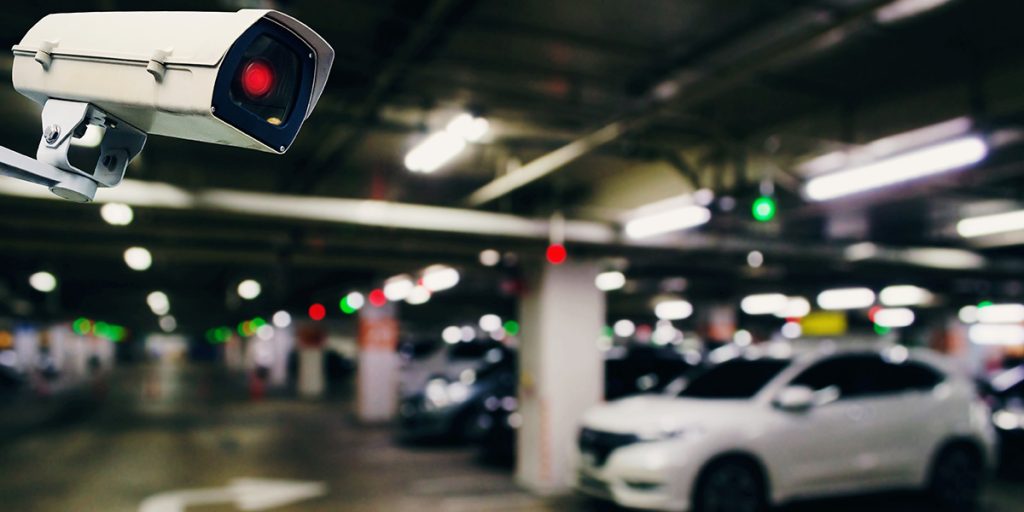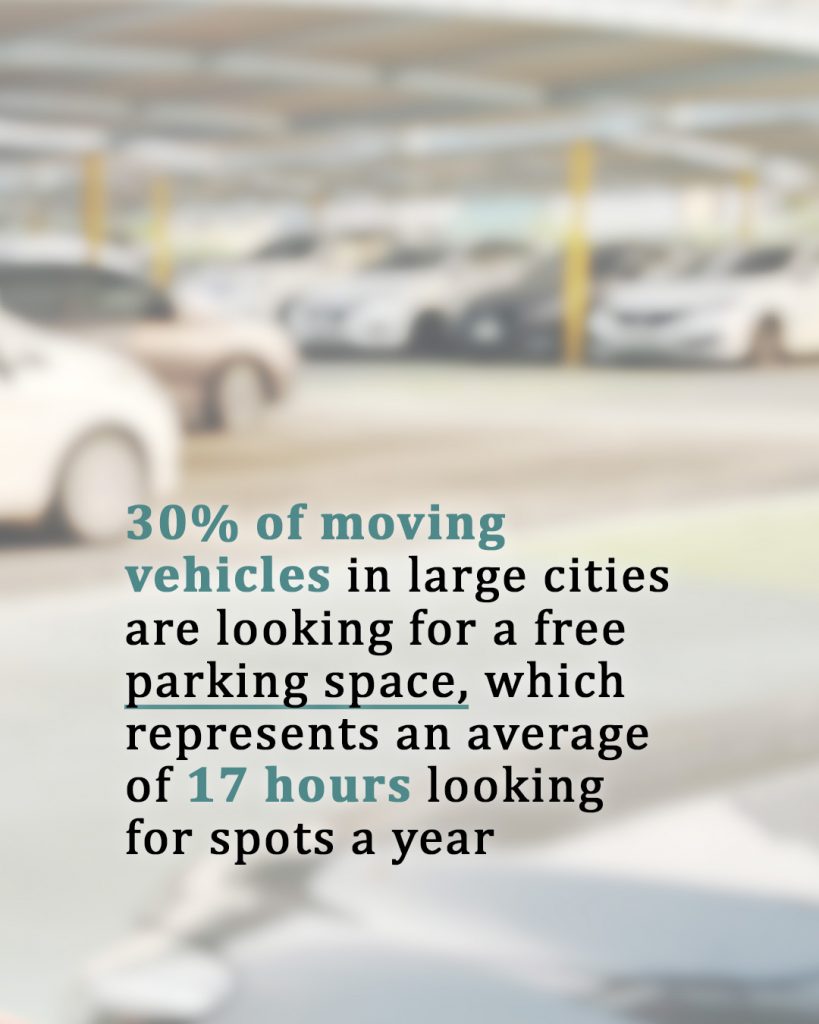Smart parking is becoming one of the most advanced indicators of the cities of the future, which will be more automated, fluid, and sustainable.
Around 30% of the vehicles we see in motion in large cities are looking for a free parking space and, generally, drivers devote almost 17 hours on average per year to find a spot. In those 17 hours, they consume fuel, delay the movement of other vehicles in avoidable traffic jams, further undermine the patience of drivers and pedestrians… and generate polluting emissions. In the US alone, it is estimated that the impact of congestion on the health of the population will far exceed €15 billion in 2030.
Naturally, the worst part of the related health issues are the illnesses caused by traffic. Almost 20,000 people died in the world’s largest economy in 2017 because of car pollution alone, according to a Harvard study. On the other hand, traffic causes noise pollution and leads to other medical problems, to the extent that, for example, in the United Kingdom, they are already measured in lost years of good health.
Smart parking is one of the answers of smart cities to all these enormous challenges. And its application depends a lot on regulation and the digital immersion of the end user. For example, Spain is one of the most advanced countries in the world in some smart parking technologies, because the regulations that affect private parking consumers have required license plate readers for years, something that does not happen in other European countries. Regulators in Spain consider them necessary to offer additional protection for the reading of tickets to open the exit barriers.

However, while many car parks have advanced license plate readers, it is common for the payment to be carried out manually in Spain, to accommodate, above all, the needs of the elderly population. According to a report from the UGT union, more than 14 million Spaniards do not even know what online banking is and many of them are over seventy years old.
The manual payment of the stay in the parking lot requires users to swipe tickets on a card reader and then pay by card and receive the paper receipt. Over a certain amount, they will also have to enter the card code for the transaction to be completed. And all this causes queues and delays at peak times that cannot be offset by the automatic license plate recognition systems.
Antonio García, CEO of Innova Systems Group, points out that smart parking can be deployed “at different levels that always include automated license plate recognition.” The main difference between them will lie in the way in which the transaction is paid, and the latter will depend, above all, on the level of digital immersion of end users.
Sometimes, García explains, “the payment will be made through QR codes that redirect users to a payment gateway.” Other times, he continues, “it will be carried out through mobile applications such as Apple Pay or Google Pay.” And other times, he concludes, “the user will have entered their bank details into the platform that manages the parking some time before and, as happens with Uber, the amount will be charged upon departure.”

Also, the Innova expert clarifies, this last option makes it possible to reserve parking spaces for several days. This, in some cases, can lead to employing “loyalty strategies that, for example, include a discount that makes sense for the user, who saves money and can choose a better or larger space, and for the car park operator, who knows in advance how many spots will be occupied.”
If the space is occupied for longer than agreed, the automated reading of the license plate upon departure makes it easier for users to be charged the updated amount.

Guided and regulated spaces
For Tania Josa, marketing manager of Urbiotica, another of the key services of smart parking “is guiding vehicles to free spaces.” Thus, she says, “using occupancy detection systems through magnetic sensors or cameras, these systems provide real-time information on parking availability. And that allows drivers to find free spaces more quickly, reducing the rush of traffic that creates chaos and pollution.”
In addition to vehicle guidance, she adds, “we observe a growing demand for solutions for the efficient control of regulated places. Here, smart parking projects also include solutions to alert authorities about the improper use of parking lots, using sensors or detection cameras with intelligent management platforms and mobile applications.”
These tools, she says, “based, in the case of Urbiotica, on alerting guards when infractions occur, not only facilitate greater supervision, avoiding inefficient security routes, but also help to ensure compliance with regulations and prevent fraudulent use of reserved spaces.”
Antonio García, CEO of Innova Systems Group, agrees that the management of parking spots through smart parking is promising, although the challenges are considerable: “You can’t put a camera in every square at street level because it is very expensive; you need to find, consequently, an entry and exit point from which the license plates of a multitude of regulated places can be easily recognized.”

A solution that is being applied in some places, such as Pontevedra, is for police officers to automatically check when passing by with their vehicle that the parked car meets the requirements. And this can be done through a license plate reader installed in the police car and a system that then cross-references that license plate and the information that appears, for example, in databases that include the license plates of residents’ vehicles or on limited parking payment platforms.
Smart parking technologies are not only helping to more efficiently manage private parking spaces and guide vehicles to free spaces, but also to better control the proper use of regulated spaces. Tania Josa, from Urbiotica, recalls, in this sense, the case of the Canadian city of Burlington. There, she explains, “they believed that there was not enough parking for the influx of people downtown, especially during events such as music festivals, which led them to seriously think about creating more parking spaces.” However, she adds, lacking data to support this perception, they decided to address the problem by installing occupancy detection sensors in parking spaces in the area.”
The data obtained, Josa says, “revealed a different reality: while some paid parking areas were constantly full, other nearby areas had free spots. And this proved that it was not necessary to build more parking spaces, but to educate citizens about available parking options.”


The increasing use of sensors in all new cars and the greater restrictions on vehicles in cities to limit the cost of unnecessary congestion, constant noise and polluting emissions anticipate enormous growth in smart parking services. According to EMR’s Global Smart Parking Outlook, the value of the sector’s global market will triple to almost $26 billion between 2023 and 2032. That is, in less than ten years.
Other drivers that explain this spectacular expansion are the very rapid implementation of services in the two most populated countries on the planet, China and India, and the dizzying immersion of users in the world of digital transactions even in societies with as many older users as Spain.
According to a 2023 report by the FUNCAS-KPMG Financial Digitalization Observatory, the use of digital banking in Spain increased by 30% since the pandemic, with 70% of citizens using these services. In 2028, the same source predicts that this number will grow to 85%, which is about six million additional customers.
As can be seen, smart parking, both public and private, and both underground and on public roads, is becoming one of the great assets that allow us to observe the accelerated, and sometimes invisible, gallop of smart cities. The future starts today.
Write: Gonzalo Toca